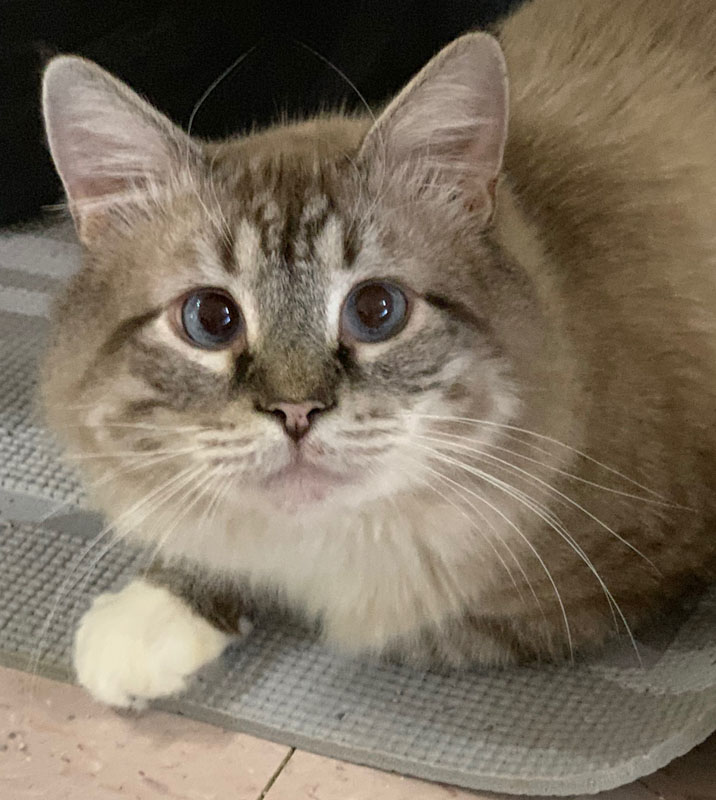Out of the box experiences! The bane of having a cat. The number one reason for cats being turned in to shelters or rescue groups. Without a doubt, the most frustrating, the most common, the most damaging issue with cat ownership.
Yes, believe it or not, one of the easier ones to solve, IF you can take the time and do the detective work. And herein lies the road to returns – too many people don’t want to take the time, or don’t have the patience to try to figure out what their cat is trying to tell them. As Director of the Siamese Cat Rescue Center for 20+ years, I have scooped and monitored litterboxes for thousands and thousands of cats. Were there some whose litterbox issues could not be solved? Sure, but the numbers were miniscule compared to how many we could solve. And I mean miniscule. 20 maybe, out of, literally, thousands of cats who came in with box issues.
They are speaking to you, you know. And if we could all understand those meows, resolving the issue might be easy. But since we don’t speak cat, we must learn to understand what they are saying by doing some puzzle solving.
1) Let’s start with the basic tenets: your cat is over six months of age and is spay/neutered. What? Your cat is not spay/neutered yet? Stop reading right now, take care of that, and then, if the issue continues, read on. Females or males, if not spayed or neutered, are highly likely to pee (urine is directed downwards from a squatting position) or spray (urine is directed horizontally from a standing position) if they are not spayed or neutered. Read that again. Females will spray as well.
2) You have been to the vet and had the cat checked for urinary tract issues. You could be wasting your time spending lots of energy trying all sorts of behavioral strategies when it could be something as simple as an infection. Both males and females can get UTIs (urinary tract infections), crystals in the urine, even bladder and kidney stones (though less common). Particularly if your cat has been fine in the box, nothing has changed in the household, and out-of-the-box experiences begin, it’s time to take a trip to the vet. No one likes to spend money unless necessary, but infections and crystals are easily treated once you know about them, so rule them out first.
3) There is an issue with the box itself. Now imagine yourself at the last restaurant, concert venue or other public place you have been, and you need to use the restroom. You find where it is (was it obvious?) and you look at the row of toilets. How many of us are going to choose one that has not been flushed? Or smells awful? Or has urine on the seat or the floor? You know the drill. We are walking down the row of toilets peering in each one to find one that looks halfway clean. Your cat is no different (and arguably cats are cleaner than most humans). They don’t want to use a toilet that is full, or filthy, or smells. They want one that is clean. Because they may need to go more than once during the day, hopefully (see below) they have more than one litterbox to choose from. The box they choose needs to be clean, which means not just keeping it scooped, but keeping it odor free. This may involve scrubbing the box on a weekly basis (or as needed). Remember that a cat’s sense of smell is much better than that of a human.
4) There is an issue with what’s inside the box, assuming we’re not talking feces and urine. In other words, what kind of litter are you using? It may be nice and fine that you prefer dust-free, flushable or some sort of organic litter, but is that what your cat likes? Cats have very sensitive noses, so not only can they detect long-term urine smells, but they are also often overwhelmed by the scented litters. While many times it is possible to convert a cat from one type of litter to another, cats with sensitive feet (in particular those that are declawed) are often averse to anything that feels too gravelly or rough on their paws (pelleted litter for example). Additionally, while it may make things easier for us, many cats absolutely hate plastic litterbox liners.
5) There is an issue with location. Flash back to the public venue you were last in when you needed to use the restroom. Was it clear where that restroom was? Was it down a dark hallway that was kind of intimidating? Did you have to go up or down flights of stairs when you were feeling a bit arthritic? Was the bathroom located where it was terribly smelly, or loud, or sketchy in any way shape or form? Ideally, all of us would like to have a pleasant and relaxing experience when we use the toilet, even if it’s a quick one, and your cat is no different. So rethink locations that are in closets, down the stairs to a dark corner in the basement, behind the noisy washing machine, etc.
6) What about the type of box? Is it hooded, because you don’t want to see or smell it, but your cat is afraid of tight spots or dark places? Is it big enough the cat can get in, turn around, dig to China, and use the box without going over the edge? Does it have a high lip they have to climb over when they are old and achy? Is it motorized and makes a scary noise if they linger too long?
7) Finally, let’s talk about the number of boxes you have. Keeping in mind what has been discussed above, unless you have nothing else to do with your time other than scoop litterboxes, you likely need more than one box. The general rule of thumb is one box per cat, plus one more. This will ensure that there is always a clean box available when the cat needs to go. If you don’t have room for more than one box, and you have litterbox issues, then rethink the number of cats you take on. If you won’t use a public restroom that hasn’t been flushed or cleaned, don’t expect your cat to be happy doing so.
Cats are very clean creatures, and they function primarily by smell. They also have good memories, so it only takes one or two negative experiences to turn a cat away from a particular box or location. If the box is uncomfortable in any way (where it’s located or what’s inside of it), they are likely to pick another place to go. How likely are you to return to a public venue where you had an awful experience?
In Part 1, we’ve touched on medical considerations, as well as talking about the location and the physical box components that are important. In Part 2, we’ll discuss the environmental, emotional and psychological issues which may affect litterbox behavior. (If you like this post and want to read more, please subscribe to the blog – you will be notified when there are new posts!)

